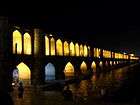Si-o-seh pol
| Si-o-se Pol | |
|---|---|
 33 Pol at night | |
| Coordinates | 32°38′40″N 51°40′03″E / 32.64444°N 51.66750°ECoordinates: 32°38′40″N 51°40′03″E / 32.64444°N 51.66750°E |
| Crosses | Zayandeh River[1] |
| Locale | Isfahan, Iran |
| Official name | Si-o-se Pol |
| Characteristics | |
| Design | Arch bridge, double-deck[1] |
| Material | stone[1] |
| Total length | 297.76 metres (976.9 ft)[1] |
| Width | 13.75 metres (45.1 ft)[1] |
| Longest span | 5.60 metres (18.4 ft)[1] |
| Number of spans | 33[1] |
| History | |
| Construction begin | 1599[1] |
| Construction end | 1602[1] |
 | |
Allāhverdi Khan Bridge (Persian: پل اللهوردیخان), popularly known as Si-o-seh pol (Persian: سی وسه پل; [ˈsiː oˈseh ˈpol], “The bridge of thirty-three spans”)[2] is one of the eleven bridges of Isfahan, Iran and the longest bridge on Zayandeh River with the total length of 297.76 metres (976.9 ft). It is highly ranked as being one of the most famous examples of Safavid bridge design.
It was constructed by the finance and the inspection of Allahverdi Khan Undiladze chancellor of Shah Abbas I, an Iranian ethnic Georgian, it consists of two rows of 33 arches from either sides, left and right. There is a larger base plank at the start of the bridge where the Zayandeh River flows under it, supporting a tea house which nowadays is abandoned due to the shortage of water and the river drought.
Image gallery
-
Inner view at night
-

Inner view at day
-

Another view
-

33 Pol night view
-
The whole view of 33 Pol at night
-
A view of the whole bridge
-
One of the bridges from top
Transportation
 Chahar Bagh Abbasi Street
Chahar Bagh Abbasi Street Motahari Street
Motahari Street Kamaloddin Esmaeil Street
Kamaloddin Esmaeil Street-
 Chahar Bagh Bala Street
Chahar Bagh Bala Street -
 Mellat Street
Mellat Street -
 Ayenekhaneh Street
Ayenekhaneh Street -

 Enqelab Metro Station
Enqelab Metro Station -

 Si-o-se Pol Station
Si-o-se Pol Station
Notes
| Wikimedia Commons has media related to Si-o-se Pol. |
- 1 2 3 4 5 6 7 8 9 Allahverdi Khan Bridge at Structurae
- ↑ Babaie, Sussan; Haug, Robert (April 5, 2012) [December 15, 2007]. "Isfahan x. Monuments (5) Bridges". In Yarshater, Ehsan. Encyclopædia Iranica. 1 XIV. New York City: Bibliotheca Persica Press. Retrieved September 25, 2015.
References
- About Si-o-Seh Pol
- Wagret, Paul (1977). Iran. Nagel's encyclopedia-guide. Geneva: Nagel Publishers. ISBN 2-8263-0026-1.
- More Pictures,Tishineh
| ||||||||||||||||||||||||||||||||||||||||||||||||||||||||||||||||||||||||||||||||||||||||||||||||||||||||||||||||||||
